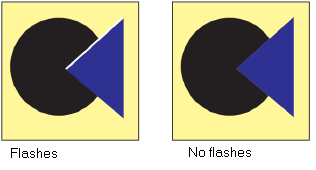
Trapping is a term that for some time has been widely used in the graphic arts industry. This term refers to the spreading and choking performed between two abutting colors.
Despite taking great care when printing multiple colors, register differences may still occur. Slight shifts (flashes, fringes) can occur at the contours of two adjacent colors.
Minimum overlaps (traps) between objects and colors are generated in the individual color separations to avoid this undesired effect.
For example, flashes occur if the printing units are not adjusted accurately. Flashes are also likely to occur if the paper used is affected by the machine or by temperature, air humidity and the moisture content of inks. If the adjacent colors are relatively dark, even a very narrow flash is noticeable and cannot be overlooked.

The simplest way of avoiding flashes is by spreading the lighter color into the darker color. During an overprint, the colors will overlap slightly and no flashes will occur even if there are slight shifts in color.
In the example given below, the graphics on the left are not trapped while those on the right are (by spreading the color).

Example: A
In this case, the color of the square is "lighter". By spreading the color, the corresponding separation on the right side is larger when exposed. The colors overlap in the overprint.
Example: B
In this case, the color of the base is lighter. By spreading the color, the knockout size of the letter "H" becomes slightly smaller in that separation. The colors overlap in the overprint.
Another way of avoiding flashes is to insert white gaps between abutting colored areas. This process is also known as "white framing".
|
|
Fig. 1 - Not only flashes caused by gaps between colored objects, but also overlaps themselves (in particular in spot colors) may be noticeable and can disturb the printed image.
In this example, the yellow triangle and the blue circle are each printed in a different spot color. |
|
|
Fig. 2 - The most common method of trapping by deliberately causing an overlap fails in this case. An overlap of these colors, whether caused by a registration error or made intentionally, results in a very noticeable green line along the border between the colors. |
|
|
Fig. 3 - If at least one of the abutting colors is quite light, then a very good alternative method to avoid risking an overlap might be leaving a white gap between the colored areas. In Fig. 3, a white gap has been left between the two objects. Offsetting the color separations against each other would also prevent overlapping. Next to yellow, the white frame is less noticeable than the green overlapping zone in Fig. 2. |